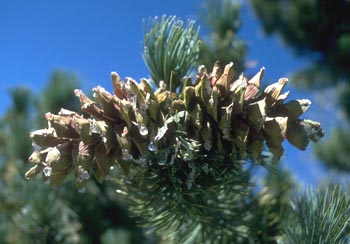Limber Pine

Common Name(s):
Limber Pine
Scientific Name:
Pinus flexilis James
Scientific Name Synonyms:
None known
Symbol:
PIFL2
Description:
Life Span: Perennial
Origin: Native
Season: Evergreen
Growth Characteristics: Limber pine is a small to medium sized tree, averaging 20 inches in diameter and 40 feet tall. Slow growing, long-lived species, sometimes taking several hundred years to reach maturity. Mature trees may exceed 1000 years of age. The central trunk is usually distorted, many branched, and twisted. Limber pine reproduces entirely from seed.
Flowers/Inflorescence: Male flowers are small, reddish cone-like structures, while female flowers are large woody cones. Both cone types are separate but found on the same tree. Mature seed cones grown on short stalks to an average length of 6 inches. Cone scales are thick and rigid. Tips of the scales are generally somewhat reflexed and smooth. Cones open when mature and the seeds fall free.
Fruits/Seeds: Seeds are small, hard-shelled nuts, about 1/3 inch long, without attached wings.
Leaves: Needle-like in "bundles" of five, 1 ½ to 3 inches long, stout, rigid, and curved. They persist on twigs for 5 to 6 years. Buds are broadly oval and pointed, near ½ inch in length.
Stems: Twigs are characteristically thick, often ½ inch in diameter near the tip, tough, and flexible. These are so flexible that they can often be tied in a knot without breaking. This characteristic gives rise to its common and species name. Bark on twigs is smooth and light gray. Trunk bark is thick and smooth on young stems, whitish gray in color. On the older trunks, it may reach 2 inches in thickness, becoming broken into nearly square plates by deep fissures. Plate surfaces are covered with dark brown to black flattened scales. Wood of limber pine is soft, generally quite weak, and white in color.
Ecological Adaptions:
Limber pine grows across a wider range of elevations that any other tree species in the central Rocky Mountains, inhabiting some of the driest sites capable of supporting trees. Most often found in more open and dry environments, and is typical on exposed, rocky mountainsides. It may be found in Utah from low elevations of about 4,000 feet right up to timberline near 11,000 feet. Reaches maturity in 200 to 300 years.
Soils: Limber pine is often reported growing on calcareous soil . It is also reported on soils derived from many other types of parent material.
Associated Species: Ponderosa pine, lodgepole pine, aspen, snowberry, bristlecone pine, Engelmann spruce.
Uses and Management:
This tree has little commercial value, but has been used considerably in the past for mine props and, in the late 1800's, for railroad ties. It has been used locally for fuel.
The large, wingless seeds of limber pine have high energy content. Pine "nuts" provide critical food for rodents and birds, which cache the seeds for later use. Other small mammals and birds benefit from these caches. Bears also feed from caches. Bighorn sheep use open stands on ridges. Difficult access and low grass production result in low forage value of limber pine stands for livestock.

